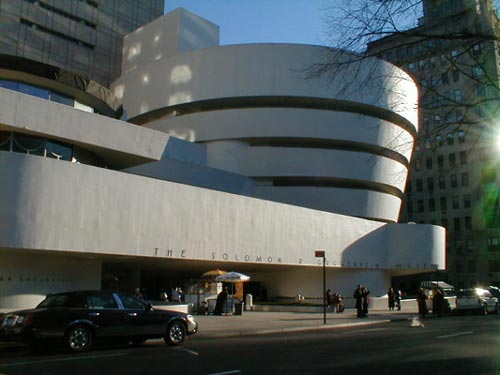Contemporary design is a direct product of a dominance of modernism and the norms associated with it, and designers and architects exploring outward and away from previous schools of design.
Two architects who influenced the start of Internationalism, and Contemporary design were Louis I. Kahn and Cesar Pelli. They are so influential because their work could not really be categorized into any stylistic category, and they were also some of the first architect/designers to gain international acceptance. This was because of the advancements in communication technology, and the ability for people to learn about design and the people involved.
Kahn was known for his “concern for expression of materials and with the ways in which light reveals form.” (Pile. Page 407) This was evident in his Utilitarian Church and School in Rochester N.Y. The materials used are kept in pure form, such as the grey masonry walls and the light seems to be coming from somewhere you can not see, emphasizing the curved form on the ceiling.
Pelli was also very influential in the move towards internationalism and contemporary design. He was more involved in larger projects such as the Museum of Modern Art in New York, and the Winter Garden in the World Financial Center also in New York. Pelli’s work also showed a concern for such things as light and the expression of materials. However, Kahn’s work showed a sense of restraint while Pelli’s work shows a tendency towards being large and exuberant and in excess.
After a move towards this style, there emerged another specific style categorized in contemporary design, Hi-tech. The term Hi-tech refers to a design based on the new advancements of technology. Hi- tech design is based on the philosophy that 50% of the cost of a project today is accumulated from the systems which make a building “work”. This includes things like elevators, plumbing and electric. Architects and designers involved in the Hi-tech movement felt that since these systems were such an integral part of making a building that they should be a focus and a large part of the design itself.
Someone who had a large part in moving along the Hi-tech style and starting it was Richard Buckminster Fuller. His designs were thought to be futuristic, dramatic and beautiful and nature. He is credited with expanding on the geodesic dome, (see picture), and coming up with such ideas for mass production. However, his designs were never mass produced
as he had hoped.
 One of the best examples of Hi-tech design was that of the Centre Pompidou, designed by Rogers and Piano. This building, which is a multi-level cultural center displays everything on the interior and exterior. The exterior shows all working systems, with one wall looking almost as though it is covered in scaffolding, with elevators and other systems outside of the facade. On the interiors pipes and tubes cover the ceiling and show an honest portrayal of what goes into making a building work. Rogers and Piano also stated that they wanted their design of this building to be able to accommodate any activity it needed to have through the changing of plan, elevation and even sections. This is such a perfect example of Hi-tech because all of the decoration and ornamentation are created with the exposed systems.
One of the best examples of Hi-tech design was that of the Centre Pompidou, designed by Rogers and Piano. This building, which is a multi-level cultural center displays everything on the interior and exterior. The exterior shows all working systems, with one wall looking almost as though it is covered in scaffolding, with elevators and other systems outside of the facade. On the interiors pipes and tubes cover the ceiling and show an honest portrayal of what goes into making a building work. Rogers and Piano also stated that they wanted their design of this building to be able to accommodate any activity it needed to have through the changing of plan, elevation and even sections. This is such a perfect example of Hi-tech because all of the decoration and ornamentation are created with the exposed systems.There was much controversy over this style and the Centre Pompidou itself because architectural critics complained, “When architecture can accommodate any activity, which may be required, it has no positive attitude towards these activities.” Alan Colquhoun. In other words- the ability for a building to change for any activity does not give the sense that it was created in the idea of being used in a certain way-something that is thought of negatively is some schools of thought. Also it was argued that keeping the systems visible was not really design. It was just using an already set form of systems and not covering them, and that there was no creativity in it.
What do you think? Do you feel that the style of Hi-tech with its abilities to adapt is a negative thing and can damage the feeling of a space? And do you feel that Hi-tech with its exposed systems is true design? Or just taking advantage of something that is “already there” in a sense?
by Monica Mooney







